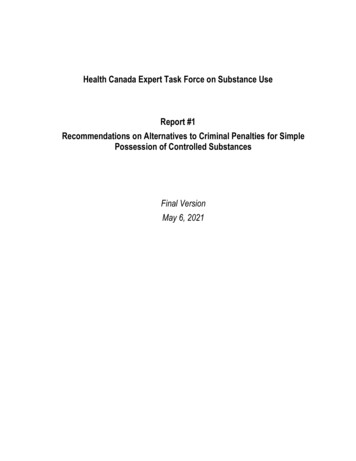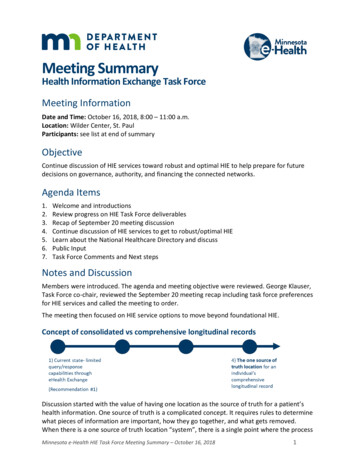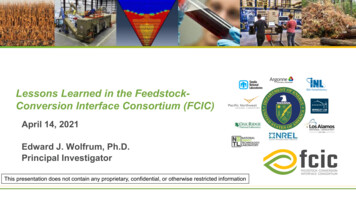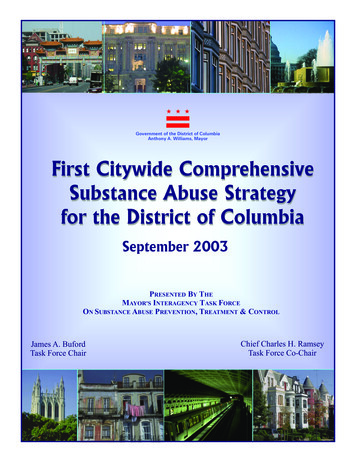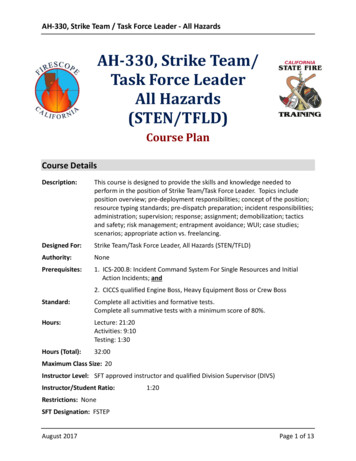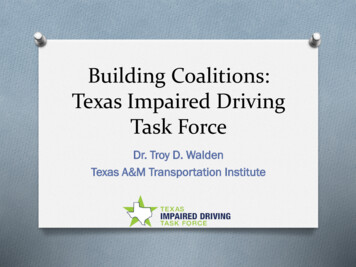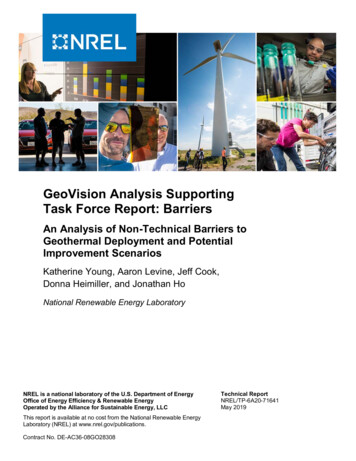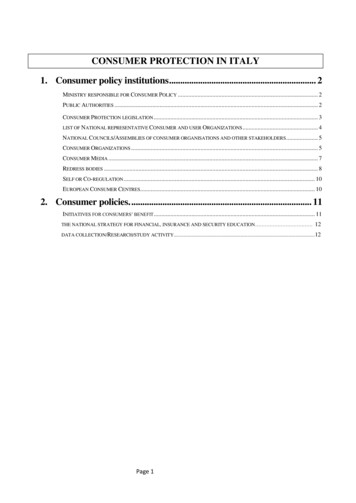
Transcription
Collaboration of the Health IT Policy and Standards CommitteesPolicy and Standards Federal Advisory Committees on Health Information Technology to the National CoordinatorConsumer Task ForceSummary of Feedback on the PGHD Draft White PaperPatty Sengstack, ChairLeslie Kelly Hall, MemberMarch 30, 2017Health IT Policy Committee and Health IT Standards Committee Work Product
Agenda Review of Charge Presentation: The Importance of Patient-Generated Health Data (PGHD)» Elise Sweeney Anthony, ONC Presentation: Overview of the PGHD Draft White Paper» Emily Mitchell, Accenture Federal Services Presentation: Consumer Task Force Feedback on the PGHD Draft WhitePaper» Leslie Kelly Hall, Consumer Task Force Member Joint Committee DiscussionHealth IT Policy Committee and Health IT Standards Committee Work Product2
MembershipMemberOrganizationRolePatricia SengstackBon Secours Health SystemsCo-ChairSusan HullCincinnati Children's Hospital Medical CenterMemberBrian AhierMedicityMemberSusan BrownTelligenMemberKevin FowlerKidney Health InitiativeMemberLeslie Kelly HallHealthwiseMemberGeorge MathewHewlett Packard EnterpriseMemberCarolyn KerriganDartmouth-Hitchcock Medical CenterMemberJohn DerrJD & Associates Enterprises, Inc.MemberAngela KennedyLouisiana Tech UniversityMemberMark SavageNational Partnership for Women & FamiliesMemberAndrea HartzlerGroup Health Research InstituteMemberJenna MarquardUniversity of Massachusetts AmherstMemberKim SchofieldLupus Foundation of AmericaMemberMargeaux AkazawaONCONC LeadHealth IT Policy Committee and Health IT Standards Committee Work Product
Consumer Task Force Charge Convened on an as needed basis, the task force will provideinsight on ONC/HHS projects/initiatives with a consumer focusto ensure the person remains at the center, engaging theexperience and feedback of both patients and providers.» Focus: The Task Force will be charged with providingfeedback on Patient-Generated Health Data (PGHD)deliverablesHealth IT Policy Committee and Health IT Standards Committee Work Product4
1ONC: The Importance ofPatient-Generated Health Data2Accenture:Patient-Generated Health DataDraft White Paper3Consumer Task Force:Patient-Generated Health DataDraft White Paper FeedbackHealth IT Policy Committee and Health IT Standards Committee Work Product5
What are patient-generated health data?Patientgenerated healthdata (PGHD) arehealth-related datacreated, recorded, orgathered by or frompatients (or familymembers or othercaregivers) to helpaddress a healthconcern.PGHD include, but arenot limited omsLifestylechoicesPGHD are distinct from datagenerated in clinical settingsand through encounters withproviders in two importantways:Patients, not providers,are primarilyresponsible forcapturing or recordingthese data.Patients decide how toshare or distributethese data to healthcare providers andothers.Source: PGHD page on ONC website, www.healthit.govHealth IT Policy Committee and Health IT Standards Committee Work Product6
Why are patient-generated health data important?PGHD can:Provide informationrelevant to preventive andchronic care managementGather health informationon an ongoing basisProvide important informationabout how patients are doingbetween medical visitsThe use of PGHD offers potential opportunities for:Increased patientengagementCost savings, such as byavoiding readmissions andreducing the need for testsImprovements in quality,care coordination, andpatient safetySource: PGHD page on ONC website, www.healthit.gov7
Health IT Certification Criteria:Patient Health Information Capture2015 Edition HIT Certification CriteriaPatient Health Information Capture §170.315(e)(3)Enable a user to:1Identify, record, and accessinformation directly andelectronically shared by apatient (or authorizedrepresentative).2Reference and link to patienthealth informationdocuments.Intent of this provision is to establish at least one means for accepting patienthealth information directly and electronically from patients in the most flexiblemanner possible.The criterion does not seek to define the types of health information that couldbe accepted as we believe this should be as broad as possible.Source: 2015 Edition Health IT Certification Criteria Final RuleHealth IT Policy Committee and Health IT Standards Committee Work Product8
1ONC: The Importance ofPatient-Generated Health Data2Accenture:Patient-Generated Health DataDraft White Paper3Consumer Task Force:Patient-Generated Health DataDraft White Paper FeedbackHealth IT Policy Committee and Health IT Standards Committee Work Product9
PGHD Draft White Paper Title: “Conceptualizing a DataInfrastructure for the Capture, Use,and Sharing of Patient-GeneratedHealth Data in Care Delivery andResearch through 2024” Author: Accenture Federal Services Posted: January 10, 2017 Available aftWhite Paper PGHD Policy Framework.pdfHealth IT Policy Committee and Health IT Standards Committee Work Product10
PGHD Draft White Paper: Research Topicsand1 CollectionValidation of Data2and Tools4 Big DataAnalysis5 DataAbility to CombinePGHD with MedicalRecord Data in MultipleWaysDonation6RegulatoryOverviewHealth IT Policy Committee and Health IT Standards Committee Work Product3 DataInteroperability7PatientRecruitment forResearch,Studies, andTrials11
PGHD Draft White Paper: Initial ObservationsCharacteristics of successfulPGHD implementations:Positive impacton patientsatisfactionTend to be focused ona specific disease orpopulation segmentUse of data analyticsSimplified userinterfaceWell-definedworkflowCare team triagesdata (not onlyphysicians)Health IT Policy Committee and Health IT Standards Committee Work ProductOpportunities resulting fromPGHD use:Patients/Caregivers: Engage inhealthy behaviors, increasetreatment adherence, andimprove health outcomesClinicians: Make timelier andbetter informed decisions,improve collaboration withpatients to create personalizedtreatment plansResearchers: Increase accessto large amounts of data,connect with patients directlyfor studies and trials12
PGHD Draft White Paper: Content Synthesizes key findings from research and outreach Discusses emerging trends and provides a vision for the future thatenables PGHD capture, use, and sharing Describes opportunities, challenges, and enabling actions for stakeholdergroups to support that vision» Stakeholder groups include:––––––Patients and ogy: Developers and Standards BodiesPayers and EmployersHealth IT Policy Committee and Health IT Standards Committee Work Product13
PGHD Draft White Paper: OpportunitiesPatients Improved patient experience and ability to engage in shared decisionmaking Reduced time, effort, and costs of patients visiting a clinical setting orresearch site and can improve workflow efficienciesClinicians Visibility into a patient’s adherence to a treatment plan Timely intervention before a costly care episode Ability to develop personalized care plan based on the needs andpreferences of each patientResearchers Access to a larger pool of participants and research data Ability to monitor adherence to study protocolsHealth IT Policy Committee and Health IT Standards Committee Work Product14
PGHD Draft White Paper: ChallengesA complex web of technical and cultural challenges may impede the successful capture,use, and sharing of PGHD in research and care delivery settings.Lack of aconsistentbusiness caseHealth IT Policy Committee and Health IT Standards Committee Work Product15
PGHD Draft White Paper: Some Enabling Actions to Consider Collaborate with clinicians and researchers to determine how capturing, using,and sharing PGHD can be valuable for managing their health. Identify and communicate benefits, challenges, and best practices of PGHD use tohelp strengthen the evidence for clinical value and business case. Call for increased funding for studies that investigate the benefits, challenges, andbest practices of using PGHD in care delivery and research. Prompt collaboration with industry to strengthen model practices, consumereducation, and outreach that support the private and secure capture, use, andsharing of PGHD. Improve usability and accessibility and implement user-centered design principlesinto products that capture PGHD. Continue to motivate clinicians to capture and use PGHD through reimbursementprograms.Patients lopers andStandards BodiesPayers andEmployersHealth IT Policy Committee and Health IT Standards Committee Work Product16
PGHD Pilot DemonstrationsPurpose To implement and test the policies and workflows identified in thewhite paper to support the capture, use, and sharing of PGHD inhealth care delivery and research settingsGoal To use insights from the pilot findings, combined with publiccomments and feedback from the joint Consumer Task Force ofthe Health IT Policy and Standards Committees, to inform updatesto the draft white paperHealth IT Policy Committee and Health IT Standards Committee Work Product17
PGHD Pilot DemonstrationsValidic/Sutter Health––Validic is working with SutterHealth to test personalized carefocused on people suffering fromType II Diabetes using remotelycollected PGHD from a multitudeof devices to research theinfrastructure and workflowsneeded to implement and scalePGHD initiativesThe pilot includes ethnographyto identify areas of improvementto further patient and providerengagementTapCloud/AMITA HealthTapCloud is working with AMITAHealth to gather PGHD andassociated clinical results intoone application across severalmedical areas such as orthopedicsurgery, behavioral health,bariatric surgery, and stroke– TapCloud connects patients andclinicians outside the clinicalsetting with the goal of identifyinghow patients feel and assessingpatient health trajectory–Health IT Policy Committee and Health IT Standards Committee Work Product18
PGHD Draft White Paper: ONC Contact InformationComments on the draft white paper may besubmitted through May 8, 2017, using thefollowing links:PGHD web plementers/patient-generated-health-dataemail: ONC-PGHD-Policy@hhs.govPatient Engagement ter-4/Health IT Policy Committee and Health IT Standards Committee Work Product19
1ONC: The Importance ofPatient-Generated Health Data2Accenture:Patient-Generated Health DataDraft White Paper3Consumer Task Force:Patient-Generated Health DataDraft White Paper FeedbackHealth IT Policy Committee and Health IT Standards Committee Work Product20
Summary of Feedback: Overall Impressions & General ThemesOverall Impressions and General Themes Members highlighted the need to identify priority use cases to buildevidence on the benefits, outcomes, and impact of the use of PGHD and todevelop proof of concepts that can help to inform standards. Members noted that some patient populations, such as special needspopulations, low-income/underserved, and those with language barriers,may not be able to participate in PGHD collection and use or have barriersto accessing and using devices that collect PGHD. Members thought conversations about PGHD collection and use shouldexpand beyond static data and consider trending data. While members appreciated the inclusion of different stakeholder groups,members noted that interdisciplinary collaboration across thesestakeholders is critical for advancing the use of PGHD.Health IT Policy Committee and Health IT Standards Committee Work Product21
Summary of Feedback: White Paper Strengths & Format SuggestionsWhite Paper Strengths Members thought the white paper was well-written and clear. Members appreciated the inclusion of different stakeholder groups. Members liked the enabling actions and real-world examples.Suggestions to Improve the Format Members suggested incorporating more real-world examples into the finalwhite paper. Members recommended using more plain language throughout thedocument to help make it understandable by diverse audiences. Members recommended that the language in the white paper continues toreflect a coordinated approach with related ONC work efforts.Health IT Policy Committee and Health IT Standards Committee Work Product22
Summary of Feedback: PGHD Definition & Current and Future StatesONC Definition of PGHD Members suggested that ONC broaden their definition to include phenotypicdata, medical history, social determinants of health, text messages, and email. Members wondered if the definition of PGHD would vary by setting. Members suggested the term be changed to “person generated health data” toexpand its scope beyond the clinical setting.Current and Future States Members suggested re-writing the future scenario so that it is more personcentric and less EHR-centric. Members were divided on extent of change likely in future vision. While somethought the scenario presented was an accurate future direction, othersimagined more automation in the future and suggested including mention ofemerging technologies.Health IT Policy Committee and Health IT Standards Committee Work Product23
Summary of Feedback: Patients and Caregivers & CliniciansPatients and Caregivers Members suggested that greater emphasis should be placed on the caregiver role andshould be discussed in more depth throughout. Members expressed the need to better understand what patients want in return forsharing their data and what motivates patients to collect, use, and share PGHD. Members stated that this section should include more discussion of the use of PGHD forbetter quality of life outcomes.Clinicians Members thought that this section should expand upon and provide more examples ofthe business case of PGHD for clinicians.» Some benefits that members felt could be expanded upon include saving time, generatingrevenue, enhanced efficiency, and reducing burden for clinicians. Members believed this section should address clinician concerns like multiple data typesand liability, and provide examples of successful implementation.Health IT Policy Committee and Health IT Standards Committee Work Product24
Summary of Feedback: Researchers & PolicymakersResearchers Members felt that researchers should be encouraged to demonstrate the value of PGHDcollection and use to patients and to return meaningful feedback to patients followingstudies. Members stated that patients must have an increased role in research that uses PGHD. Members indicated that more description is needed about the responsibilities ofresearchers regarding collecting, using, and sharing PGHD.Policymakers Members stated that this section should have more content and specifics about whichand how federal agencies are engaged in supporting PGHD use. Members suggested that this section should emphasize the need for more funding andincentives for PGHD use. Members thought that this section should also cover the role of policymakers at the stateand local levels, and mention patient advocacy groups who play a role in policymaking.Health IT Policy Committee and Health IT Standards Committee Work Product25
Summary of Feedback: Technology Stakeholders & Payers and EmployersTechnology Stakeholders Members believed that the discussion should be broadened to includeopportunities beyond technology standards. Members stated that usability issues are key not just for the technology but alsoaround the integration and presentation of the data in the EHR. Members suggested that developers must involve patients and clinicians in thetechnology design process (Human Centered Design).Payers and Employers Members thought this section should provide more discussion around thealignment of incentives to encourage PGHD collection and use in ways thatensure data quality. Members suggested emphasizing the privacy and discrimination concerns thatpatients have with giving their data to payers and employers.Health IT Policy Committee and Health IT Standards Committee Work Product26
Additional SuggestionsSuggestions for other tools and resources on PGHDAlthough possibly outside the scope of the white paper, members hadadditional suggestions for tools and resources that could encourage PGHDcollection and use: Develop a table that illustrates types of PGHD by technologies and devicesthat collect these PGHD. Provide actionable advice and guidance on how different stakeholdergroups can integrate and use PGHD in their work. Create more educational materials on PGHD for different stakeholdergroups. Identify relevant and actionable information related to PGHD capture, use,and sharing as it relates to new policies and rules supporting MACRA/MIPSand 21st Century Cures.Health IT Policy Committee and Health IT Standards Committee Work Product27
Collaboration of the Health IT Policy and Standards CommitteesPolicy and Standards Federal Advisory Committees on Health Information Technology to the National CoordinatorConsumer Task ForcePatty Sengstack, ChairLeslie Kelly Hall, MemberHealth IT Policy Committee and Health IT Standards Committee Work Product
Angela Kennedy Louisiana Tech University Member Mark Savage National Partnership for Women & Families Member Andrea Hartzler Group Health Research Institute Member Jenna Marquard University of Massachusetts Amherst Member Kim Schofield Lupus Foundation of America Member . bariatric surgery, and stroke .

